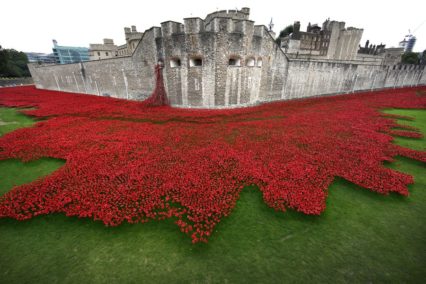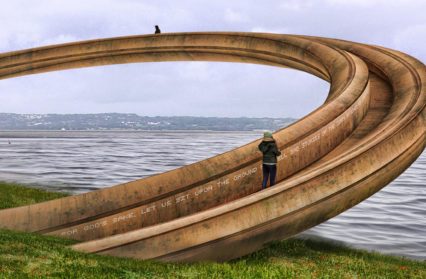Adam Somerset checks in on the debacle surrounding the proposed ring at Flint Castle, and looks at the perils fixed to the pleasures of public art.
In December, Private Eye featured an item on the arts in Wales. To reach that magazine’s columns made it unlikely that it would be good news. In fact, the writer returned to a familiar subject, the sculpture intended for Flint. If something were not built soon, said the contributor, the government money of £62,500 would be forfeit and returnable to Cardiff.
The sculpture suffers from a triple jeopardy. The article about the proposed Ring the first time around in Wales Arts Review in 2017 was titled “The Perils of Public Art.” Public art runs the risk of being politically inflammatory. The war in eastern Ukraine was propelled by the felling of dozens of statues of Lenin. “Blood Swept Lands and Seas of Red” at the Tower of London in 2014 was generally perceived to be a success. But not by all. It was attacked on the grounds that the number of ceramic poppies, 888,246, was a nationalistic insult to the hundreds of thousands recruited from Empire and beyond. The true number should have been 1,118,760. Art critic Jonathan Jones was of the view that memorial must by default contain horror. “The moat of the Tower”, he wrote in The Guardian, “should be filled with barbed wire and bones. That would mean something.”
 If history is incendiary so too are borders. The shores of the Dee were always going to be choppy waters. The mix of motives – art and tourism – is uneasy. Martin Johnes presented an Archive on 4 in July 2019. His subject was not Flint but it could equally as well have been. A lack of confidence expressed itself, he said, with “anger around symbolic moments, particularly where Wales can be perceived as a victim.”
If history is incendiary so too are borders. The shores of the Dee were always going to be choppy waters. The mix of motives – art and tourism – is uneasy. Martin Johnes presented an Archive on 4 in July 2019. His subject was not Flint but it could equally as well have been. A lack of confidence expressed itself, he said, with “anger around symbolic moments, particularly where Wales can be perceived as a victim.”
Sculpture does not even have to be at a physical border to cause trouble. Peter Lord as an artist was as well qualified as any to execute a commission in the 1980s in Whitland. As he describes it in in his autobiography, the project Cofeb Hywel Da aroused the ire of the Labour Party. The artist set to his work and a resident would stop each day with “why don’t you f*** off back where you came from?” Croeso yma.
A third problem is ownership. A film or a theatre production may be good or not at all good. At least there is a director to kick it into being and take the rap. The saga of Flint first time round was the lack of conviction, with the exception of the poor artist. When it was assaulted online its backers ran for cover. Its abstraction did not help. From the 2017 article about Flint: “The problem is that the meaning of an artwork does not belong to the makers.” With abstraction the meaning is in the eye of the beholder.
Some nice public art in the west is different, both smaller and more figurative. The sea is another border but less contentious. Ceredigion is home to a trio of public works made in recent years. Llangrannog has been overlooked by Saint Crannog by the sculptor Sebastien Boyesen since 2012. The features are finely rendered and the site has a circular seat of slate for the cliff-walker. It is a place I like a lot.
In the summer of 2014 sculptor Ben Dearnley worked on a live carving project at Borth. The theme was the tower with the bells that toll beneath the sea. The verse is by poet J.J. Williams (1869-1954). From Clychau Cantre’r Gwaelod:
“ O dan y mor a’i donnau Mae llawer dinas dlos
Under the sea and waves lie many a fair city.”
The artwork has relief carvings of waves that crash onto towns and cities. The watchman Seithennyn features, asleep at the unclosed sluice gates. The sculpture is aligned to capture the setting sun through the hole with the bell. At the summer solstice on the 21st June it sets just beyond Ynys Enlli. The carving also depicts the tree species in the fossilized forest, oak, pine, alder, birch.
In the summer of 2019 another sculpture joined the public art of coastal Ceredigion. Newquay is the exact mid-way point for the journey by sea from Newpoint to Chester. It features the benign wind that powered the coastal traffic and has an inscription composed by Newquay resident and poet Samantha Wynne-Rhydderch. A tight commission in terms of length, theme and language her poetry reads:
Loaded with coal, the ships built in this bay
once tacked their way under canvas across oceans
and back. May these same winds breathe at your heels
to guide your steps along shale and shorelineof our coastal path. Ar hanner eich taith
cymerwch hoefan hyn, a chyn troi llygaid
i’r gogledd neu traid i’r de, rhowch gusan i’r Cei,
ei chychod, ei chwedlau a braich ei bae
The scene at Newquay is brightened greatly by the new installation. These three pieces of public
sculpture stand where land and sea meet. There are inland pieces too, the Welsh cob opposite the
Feathers Inn in Abereron, the osprey at Cors Dfyi. These pieces of public art up and down
Ceredigion ennoble and enrich their settings, whether they be cliff-top, beach or road-side. If there
are lessons to be had from them with regard to the Flint venture they might be: be specific, avoid
the grandiose and let the work be done by artists who connect to the location with the advantage of
living there.
Adam Somerset is a regular contributor to Wales Arts Review; his collection of essays, Between the Boundaries is available now from Parthian Books.











